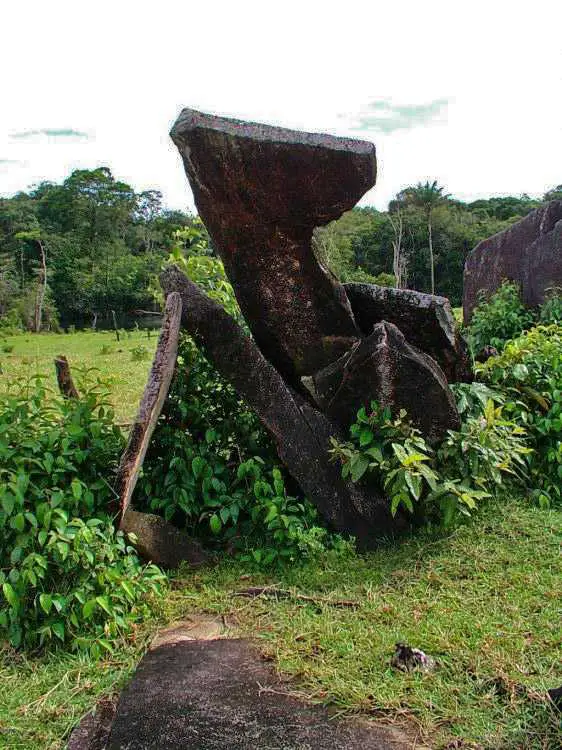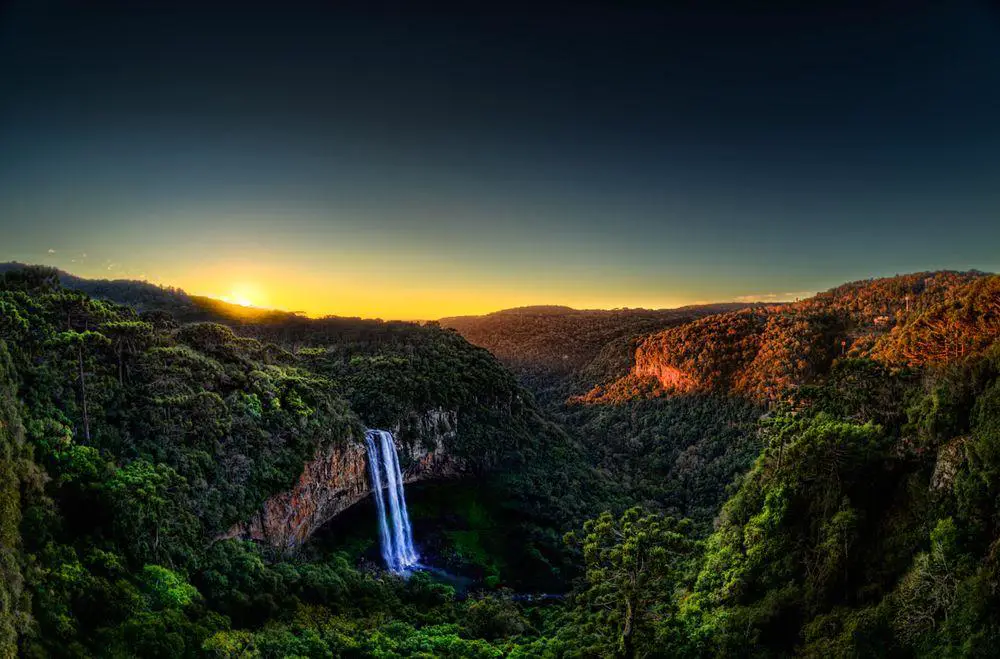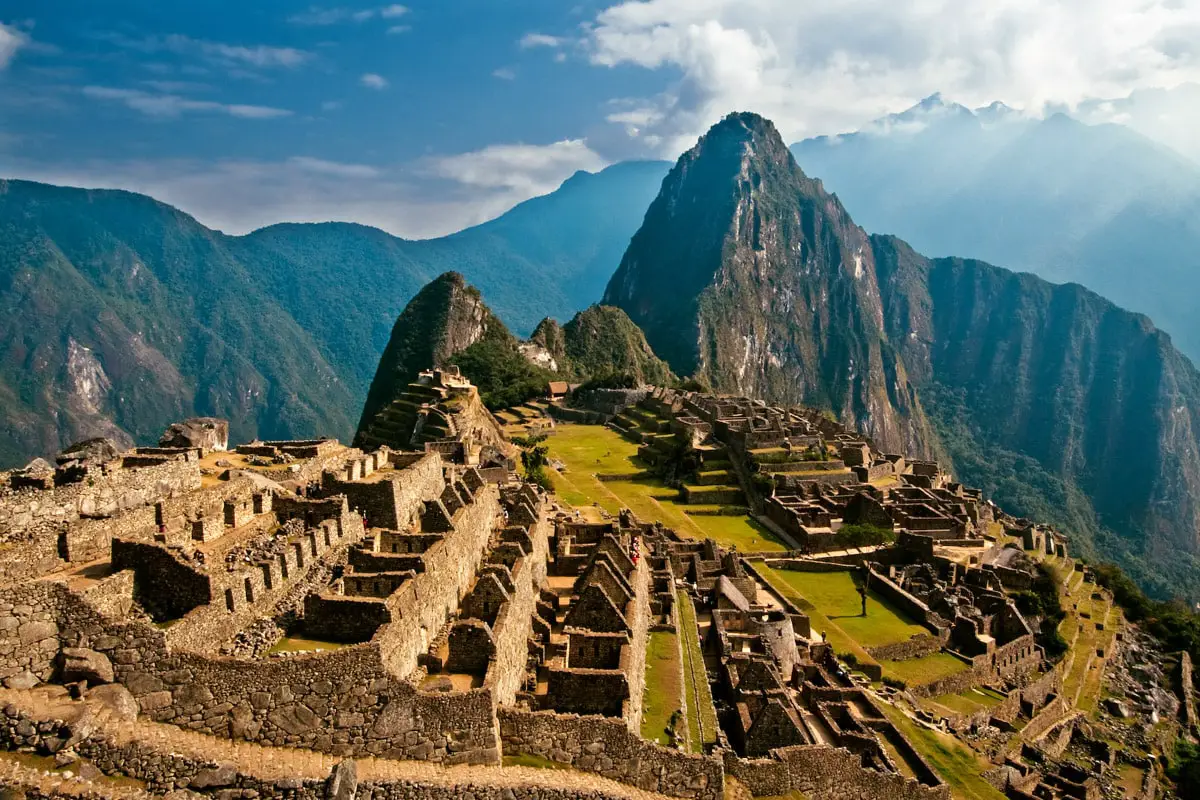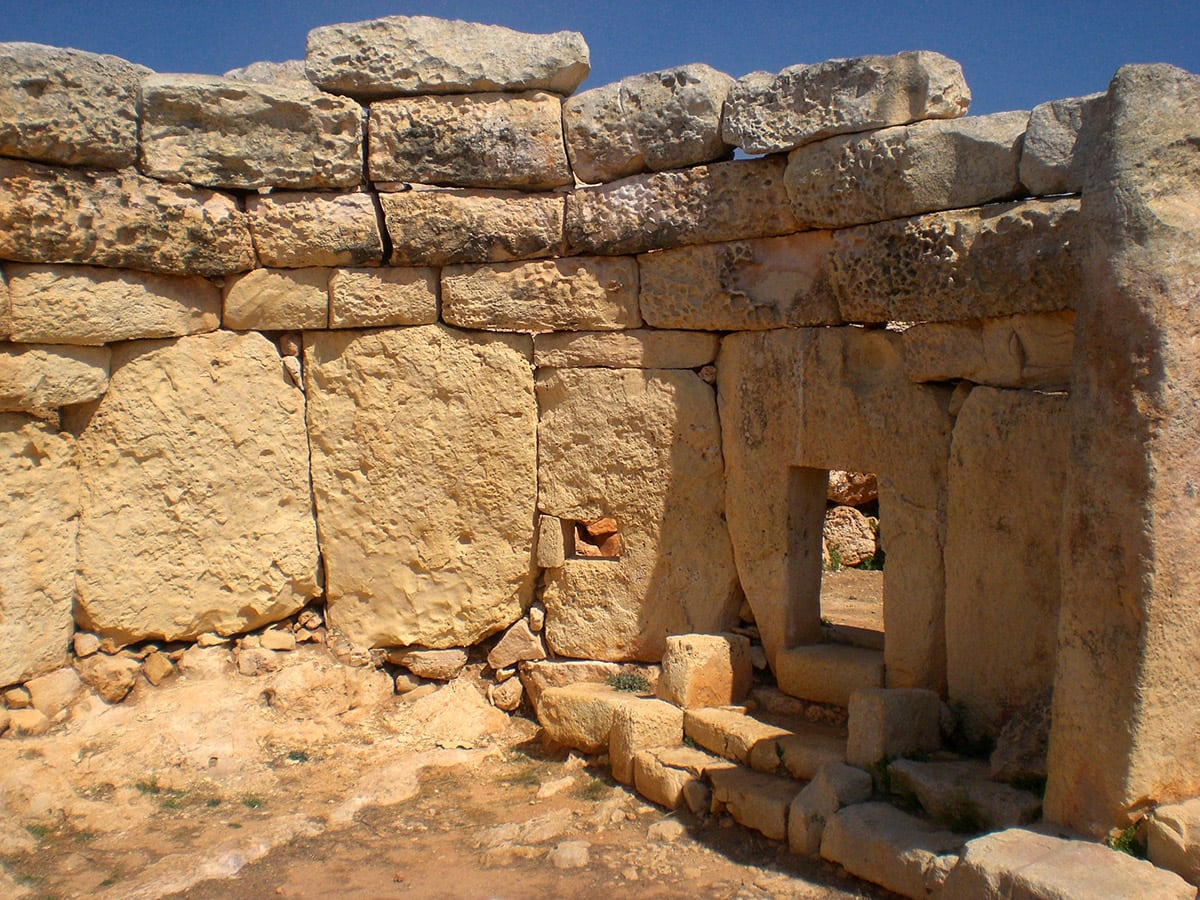World 🢖 South America 🢖 Brazil 🢖 Amapá
Megaliths 🢔 Archaeological wonders 🢔 Categories of wonders
Wonder
Calcoene megalithic observatory – Amazon Stonehenge

 In short
In short
Sometime in the past in the north-east of Brazil there were living people who created beautiful pottery and built megalithic structures. The best known monument left by these people is Calçoene megalithic observatory (Calcoene megalithic observatory), often called also Amazon Stonehenge. Ancient builders of this structure used interesting methods to mark the winter solstice – this site served as ancient astronomical observatory.
 43.8%
43.8%
GPS coordinates
Location, address
Alternate names
Construction time
Culture
Map of the site
If you see this after your page is loaded completely, leafletJS files are missing.
 In detail
In detail
Recent discovery
Megalithic structures in Amapá were first reported by naturalist Emilio Goeldi – he noticed settings of upright stones in the late 19th century.
Scientific interest in these monuments appeared in the 1920s when Curt Nimuendajú described 9 groups of megaliths here, some research has been performed also later.
The first real research program started here only in 2005 when there was gathered information in a larger area and made first excavations in one site – Calçoene megalithic observatory or as the reserved scientists prefer to call it – structure AP-CA-18.
Recent findings attest that there existed one of the most interesting ancient South American cultures outside the Andes region.
Megalithic culture of Amapá
Unfortunately the age of the Amapán megalithic culture is knot known yet. It is considered that this culture was active mainly sometime between the 1st – 10th century AD and maybe – up to the 15th century, when (so it seems) it disappeared.
Lowland
Coastal regions of Amapá are considered to be a part of the enormous delta of Amazon (Foz do Amazonas) – the muddy sediments along the coast have been brought by this giant river.
This low-lying area is subject to frequent flooding. The tidal difference here is approximately 5.2 meters and during the rainy season (and here it rains a lot) the rivers turn the land into an endless swamp.
Due to this megalithic structures in Amapá is located at some distance from the ocean. Calcoene megalithic observatory, for example, is located some 17 km from the ocean. Here the level of rivers still is just a few meters above the level of oceans but at the banks of rivers appear first small hills. Frequent floods prevent the formation of the rainforest – in the dry season of the year these floodplains are covered with meadows and frequent forest islands.
Further away from the sea the area is gradually rising and there appear cliffs.
Diverse archaeological monuments
Occasional finds from earlier years and reconnaissance work since 2005 have brought to our knowledge numerous diverse and interesting archaeological monuments in this part of Amapá.
Until late 2005 there have been found 20 megalithic structures, 8 burial caves as well as sites of ancient villages (some on artificial mounds), burials, and votive deposits of ceramics at hilltops – in total 55 archaeological sites.
Megaliths, in general, are located at some distance from the sea, on small hills. Like in Europe, megaliths here are located within a view of some water body – here: rivers. Megalithic structures are located at characteristic locations – such as sharp bends of rivers, a confluence of two rivers.
Further away from the coast, where appear first cliffs, there is found another kind of monuments – caves with ceramic funeral urns.
Contrary to nearby areas in French Guiana there have not been found signs of agriculture thus far. Here, in northern Amapá though are discovered remnants of large settlements where buildings covered more than 1 km long area. This culture created impressive ceramic vessels as well – maybe less sophisticated than the neighboring Marajoara culture but still beautiful and unusual.
Megaliths
Amapán megalithic culture does not impress with the giant size of the stones but contrary to most other megalithic monuments of the world here these structures have been preserved intact. Here megaliths contain lots of interesting artifacts and present great value to science.
For the most part, Amapán megaliths are easily visible, they are located on the tops of hills. Megaliths consist of upright or slanted granite blocks in circular arrangements. Some circles are small, less than 10 m in diameter – these megaliths consist of smaller stone blocks less than 1 m tall.
The largest structure is AP-CA-18 with a diameter of more than 30 m. Here are the largest stone blocks – some even up to 4 m tall. In general larger megalithic structures here tend to have larger stones.
Some megaliths are not circular but linear – here stone slabs are placed in alignments along the rivers. Such megaliths are located on oblong, narrow hills, and the length of these structures can reach 100 m.
Megaliths are located along the rivers and usually, there is some 2 km large distance between megaliths or groups of megaliths. Most likely these structures designate centers of smaller territorial units.
In general Amapán megaliths show a close relationship between the natural landscape and man-made structures. Stones are left rough, unworked. It is speculated that these natural rocks intentionally were not hewn or polished – they were left in the original state to keep their original essence, "spirit".
Structure AP-CA-18 – the astronomical observatory
The largest (known) Amapán megalith is structure AP-CA-18 and exactly here were made the first excavations in 2005, bringing new knowledge and even more unanswered questions. It seems that this site served as a burial site and ancient observatory.
This extremely well-preserved megalith is located on top of a hill rising above the Rego Grande river. Large, up to 4 m tall, upright stone slabs are easily noticeable and the site was locally well known already before excavations.
Excavation was done here with great care with an aim to keep rocks intact in their original positions – thus Amapá obtained famous and authentic tourist attraction.
Site consists of two megalithic structures, each on its own hilltop. One is a circular stone setting – this is the famous observatory. Another is a group of upright slabs without a definite shape. This site contains several more archaeological monuments including two pits with lots of ceramic shards.
The circular stone setting consists of 127 blocks of granite.
Pits with ceramics and bones
One of the most impressive finds during the excavations was impressive, unusual pottery.
During the excavations there were found two pits among the upright stones – one was filled with shards of ceramics, another – with intact and nearly intact large ceramic vessels. Both were covered with large stone slabs.
The first of these pits was approximately 1.7 m deep – it was filled mainly with broken ceramic urns. One nearly intact vessel contained fragments of cremated bones – initially this vessel was thrown into the pit intact and broke there. At the deepest layer here were found three intact urns with red pigment, placed in a triangle. Evidence shows that this pit has been used repeatedly.
The other pit was covered with 1.8 tons heavy granite slab. Below this lid was found seven nearly intact large ceramic urns and one lid for one of those urns. Inside these urns was soil with charred bones. This pit most likely has been used only once and with great care.
There were found several smaller pits which also contained ceramic vessels – smaller bowls. In some areas were found whole layers of ceramic shards, especially numerous finds were made near a prominent standing stone which has a hole in it.
Ceramic vessels here have interesting sculptural decorations in the shape of human heads, monkeys, birds, reptiles, frogs. Some urns are anthropomorphic and were formed like a somewhat funny, obese man with small hands. Some shards show that also polychrome (red + black + white) ceramic was used, many vessels are adorned with ornaments.
It is speculated that finds of bones in megalithic structures do not mean that these structures were used as graveyards. It may be that megaliths contained bones with intent, to make them more potent – like in European churches, there are reliquaries of medieval saints.
Archeoastronomy or Amazon Stonehenge
Only shortly before the start of excavations it was noticed that the stones in this megalith may have a specific, astronomic orientation.
Prehistoric sites with archeoastronomic orientation are met in the Andes – such structures have been found in Colombia, Peru. In Brazil, there have been found representations of constellations in petroglyph sites. It was known that indigenous people of the Amazon basin have knowledge about the movement of the Sun and Moon but Calcoene megalithic structure shows that they may have implemented this knowledge in structural design as well.
Here should be noted that not all are convinced that AP-CA-18 has something in common with archaeoastronomy. After all – 127 blocks of granite may have lots of interesting coincidences created without intent.
Thus far it is considered that Calcoene megalith is oriented at sunrise of the winter solstice, while there were not found any effects for summers solstice, spring, and autumn equinoxes.
Further research showed that certain rocks are inclined to show the curve of the Sun. They are placed under an angle to achieve minimum shadow from these rocks throughout the day of the winter solstice. In order to keep these weighty rocks in the desired position, they were carefully supported with other – support – stones which for the most part are below the soil level now.
It is even weird to look how this very thin but otherwise enormous slab has a very narrow strip of shadow throughout the whole day of the winter solstice (21 – 22 December). Such a stone slab may have served as a very good calendar too.
Behind this stone slab there is another with a hole in it. When looking through this hole towards the Sun during the winter solstice, the Sun is hidden behind this narrow, slanted slab throughout most of the day.
Unexplained and exciting
Research shows that this exciting monument is unique for Brazil. As usual, during the excavations, there were answered some questions but arose numerous new ones. Some are obvious – there needs to be determined the age of the culture, made reconnaissance for other megalithic monuments and some more works of technical nature.
But there is a lot more to think and research. For example – the megaliths of Amapá need to be further researched to find whether these amazing monuments have been created by a single culture or there have been performed different rituals in different times. It is also interesting to see the diverse burial traditions in this region where some deceased were buried in caves but others – in such megalithic structures.
Site is recognized to have high tourism value and the research and popularisation have been organized with great care to provide a good background for the preservation of the site. The strategic approach of scientists helped to found the archaeological park – Parque Arqueológico do Solstício.
Discovery of the Calcoene megalithic observatory (yes, possible observatory) has changed the way how people look at the history of Amapá.
References
- J.D. De Moura Saldanha, M.P. Cabral, As Estruturas Megalíticas Na Foz Do Amazonas. Grupo de Estudos do Megalitismo Alentejano.
 Linked articles
Linked articles

Wonders of Brazil
Brazil is an enormous, diverse country with many amazing and unique attractions. Especially impressive are the diverse natural landmarks – many surprising geological monuments and areas with unique and endemic plants and animals. Few know it outside the country – but there are many beautiful historical cities. Many great monuments of architecture have been created in Brazil in the 20th century.

Wonders of South America
There is little doubt – South America is one of the most spectacular… maybe the most spectacular continent of the world.
There is located the second-highest mountain chain in the world, the largest rainforest, the tallest volcanoes, and the tallest and largest waterfalls. The highest biological diversity in the world is reached somewhere near the eastern ranges of the Andes in Ecuador, Peru, or Colombia.

Megaliths
One of the most fascinating groups of archaeological monuments are prehistoric structures made of stones – megaliths. Through the ages, people have loved to strain their minds to find a sensible explanation for the many riddles posed by megaliths.
Even today, we can admit with some pleasure, there are thousands of mysteries left for us.
 Recommended books
Recommended books


